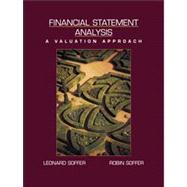
Leonard Soffer is Associate Professor of Accounting at the University of Illinois at Chicago, where he teaches courses in Corporate Valuation and Advanced Accounting to both undergraduate and graduate students. He has also taught graduate students at the Kellogg Graduate School of Management and the University of Chicago Graduate School of Business, as well as executive education students at Kellogg and in an executive education program for a major accounting and consulting firm.
Professor Soffer has a B.S. in Accountancy from the University of Illinois at Urbana-Champaign, an M.B.A. in finance and information systems from the Kellogg Graduate School of Management, and a Ph.D. in Accounting from the University of California at Berkeley. He is a Certified Public Accountant and a winner of the prestigious Elijah Watt Sells Award for his performance on the C.P.A. exam. Professor Soffer is a member of the American Accounting Association, the American Institute of C.PA.s and the Illinois C.P.A. Society. He serves on the Accounting Principles Committee of the Illinois C.PA. Society.
Professor Soffer's research focuses on security analysis, the role of security analysts, and the use of financial statement information. His work has appeared in the Journal of Accounting Research, the Review of Accounting Studies, Contemporary Accounting Research, the Journal of Accounting, Auditing and Finance, Accounting Horizons, Managerial Finance, the Review of Accounting and Finance, and Investor Relations Quarterly. He is a member of the editorial board of the Review of Accounting and Finance. Professor Soffer's research has been cited in Business Week, Crain's Chicago Business, and Worth Magazine. He has appeared on the Chicago CBS television affiliate and on WebFN, a Web-based business news station, to discuss the state of the accounting profession, his research, and regulation of financial disclosures.
Prior to entering academia, Professor Soffer worked in accounting and corporate finance positions, most recently as manager of corporate development for USG Corporation, where he worked on acquisitions, divestitures and corporate strategy issues for the Chicago-based construction products firm. Professor Soffer has served on the board of directors of a not-for-profit corporation providing services to the developmentally disabled. He and his wife/co-author live in the Chicago area with their three children.
Robin Soffer is a consultant specializing in financial analysis and business strategy. As part of her consulting work, she runs the financial training programs at Quaker Food and Beverages, a division of PepsiCo. She has taught finance and accounting at the undergraduate and MBA levels at Dominican University, Concordia University and Keller Graduate School of Management.
Robin has a B.S. in Accountancy from the University of Illinois at Urbana-Champaign and an M.B.A. in finance and marketing from Northwestern University's Kellogg Graduate School of Management. She is a Certified Public Accountant and a winner of the prestigious Elijah Watt Sells Award and the Illinois Silver Medal for her performance on the C.P.A. exam.
Before becoming a consultant, Robin spent fourteen years at The Quaker Oats Company in finance, planning and general management. Her finance experience includes corporate and divisional financial analysis, strategic planning, cash management, international financing, pension and profit sharing investment management, and directing Quaker's acquisitions and divestitures. Her most recent position was Vice President and Assistant Treasurer. Robin was also the General Manager of Ghirardelli Chocolate, a Quaker division. In this position, she was responsible for all aspects of the business including sales, marketing, plant operations, and retail stores.
Robin lives with her husband/co-author and three children in the Chicago area.
I. INTRODUCTION TO SECURITY ANALYSIS.
II. BUSINESS AND FINANCIAL ANALYSIS.
III. CASH FLOW VALUATION MODELS.
IV. SPECIAL ISSUES IN VALUATION
V. MULTIPLES VALUATION.
The New copy of this book will include any supplemental materials advertised. Please check the title of the book to determine if it should include any access cards, study guides, lab manuals, CDs, etc.
The Used, Rental and eBook copies of this book are not guaranteed to include any supplemental materials. Typically, only the book itself is included. This is true even if the title states it includes any access cards, study guides, lab manuals, CDs, etc.